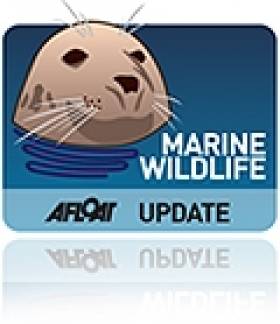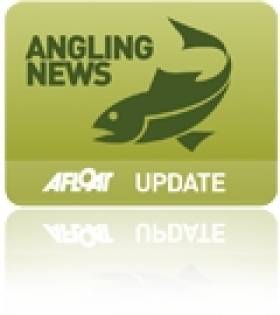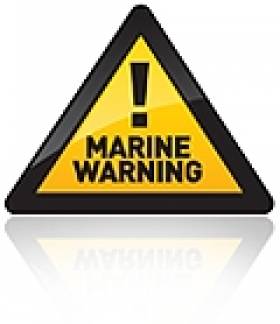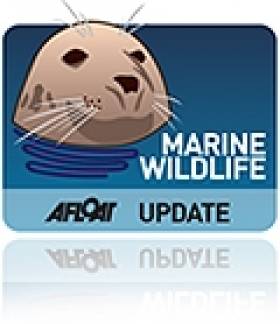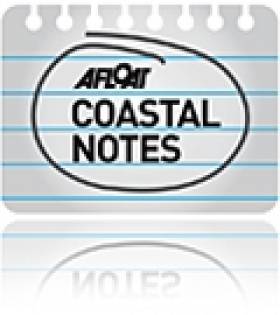Displaying items by tag: irish sea
Isle of Man Begins Seal Pup Survey
#MARINE WILDLIFE - The Manx Wildlife Trust has commenced its annual survey of seal pups on the Calf of Man, as Isle of Man Today reports.
Volunteers will be on watch at the island nature reserve, off the southwest coast of Man proper in the Irish Sea, for the next four weeks to develop a complete picture of the area's grey seal pupping season.
As of Sunday 14 October, some 14 seal pups have already been born, which is a few less than last year, according to marine officer Eleanor Stone - though she notes "there are still many pregnant females around, just waiting for their time to give birth".
Stone, who is volunteering on the first week-long shift, said the trust has already spotted six seals recognised from previous years, and it is expected many more will be returning to the sheltered beaches of the islet.
Isle of Man Today has more on the story HERE.
UK Conference to Uncover Secrets of the Irish Sea
#MARINE WILDLIFE - A marine wildlife conference in Cumbria aims to delve deep into the Irish Sea to uncover some of its fascinating secrets.
The Living Seas North West Conference takes place at the Netherwood Hotel in Grange-over-Sands next Friday 19 October and presents an opportunity to discover the diversity of wildlife we have in the Irish Sea – a magnet for hundreds of species from huge basking sharks to tiny molluscs and many varieties of birds.
“The Living Seas North West conference is a chance to learn more about the Irish Sea – what’s in it, what activities go on, what impacts these have had, how it was managed in the past, how it is being managed now and how can we approach its management in the future,” said Cumbria Wildlife Trust marine conservation officer Lindsay Sullivan.
World renowned ocean expert Professor Callum Roberts and explorer, naturalist and TV personality Paul Rose will be among those giving talks on the day, and there will also be discussions hosted by experts from around the UK and Ireland on topics from offshore development and fishing to coastal zone management.
And for anyone aspiring to a career in the marine or coastal environments, the afternoon careers session will introduce them to seasoned experts offering their views on how to land your dream marine job.
The Living Seas North West Conference, hosted by the Irish Sea Wildlife Trusts, runs from 9am-5pm on Friday 19 Octover. Admission is £35 per person (#15 for under-25s and students) and includes a buffet lunch, tea and coffee, and a full delegate pack. For further details visit www.irishsea.org.
Hopes for Evidence of Coral Reefs in Irish Sea
#MARINE WILDLIFE - Might there be evidence of coral reefs in the Irish Sea? Johnny Woodlock of the Irish Seal Sanctuary believes so.
Writing for Wildlife Extra, the Sea Fishery Advisory Group member recalls seeing a piece of coral that a former commercial trawler skipper said he had found in one of this nets more than 20 years ago while fishing off the Isle of Man.
Woodlock says he identified the sample as Lophelia pertusa, a coldwater coral that thrives in deeper water and one that was not previously linked to the Irish Sea, according to the records of the Marine Institute and the National Parks and Wildlife Service.
Then this past August, when Woodlock uncovered a similar piece of coral and identified it as the same species, he was able to find out the co-ordinates where both pieces had been netted and forwarded them to the Marine Institute.
Though the area of the Irish Sea in question "has been heavily trawled by larger boats pulling heavier nets for a number of years", Woodlock remains hopeful that the Marine Institute can find evidence of living coral in the depths.
Often mistaken for plant life, coral is actually a compact colony of very simple marine wildlife called polyps, encased in a skeleton of calcium carbonate which gives them their solid appearance.
Marine Life Researchers Get Free Passage Across Irish Sea
#MARINE WILDLIFE - Seatruck Ferries is providing free passage this autumn for surveyors with a UK-based marine wildlife charity to discover how many dolphins and seabirds make their home in the Irish Sea.
MARINElife will be extending its marine conservation research on existing sailings operating between Liverpool and Dublin - and it is hoped its surveyors will spot a variety of cetaceans en route, including minke whales, common dolphin, Harbour Porpoise and Risso's dolphins.
Grey seals, basking sharks and a host of seabirds from the gannet to the Manx Shearwater, which winters off the coast of Brazil, may also be spotted.
The charity will be running monthly scientific surveys - the first started last week on 27th September – and its recorded sightings will be posted on the MARINElife website.
It's expected that the data collected will contribute to a better understanding of the distribution and abundance of dolphins, porpoises, seals and seabirds in the Irish Sea.
The research with Seatruck Ferries also contributes to a larger project operating on ferries around the UK coastline.
Kevin Gilland, Seatruck Ferries representative involved in the project, said: "We are delighted to expand our help to MARINElife so they can further develop the understanding of the wildlife in the area. We look forward to hearing more about the wildlife encountered on these routes."
Adrian Shephard, trustee for MARINElife, commented that "ferries, or ships of opportunity as we refer to them, are a very convenient way of carrying out off-shore surveys.
"They allow us to access the same areas of ocean and monitor for changes over time - vital information which forms the basis of conservation decisions."
MARINElife research director Dr Tom Brereton described the ferry routes across the Irish Sea as "particularly vital as the area is an important passage for whale, dolphins, sharks and even turtles."
Welsh and Irish Ministers Check Out Celtic Sea Trout Project
#ANGLING - Sea trout were top of the agenda at a recent meeting between Welsh Deputy Fisheries Minister Alun Davies and Minister of State Fergus O’Dowd at Leinster House recently.
Both ministers were briefed about progress with the INTERREG IVa Ireland-Wales-funded Celtic Sea Trout Project, which finishes in 2013.
Sea trout are present in most coastal rivers discharging into the Irish Sea, and their status in freshwater and in the marine environment is central to the project.
By providing detailed information about the status of sea trout stocks, their genetics and their varied life histories, the project aims to enhance the fisheries for the benefit of all stakeholders.
Other important aims of the project are strengthening the contribution of sea trout to rural economies, to general quality of life and well-being and to national biodiversity - while sea trout life history variation may also contribute to understanding the effects of climate change.
For sustainable management the Celtic Sea Trout Project team is working on developing a number of management tools which will assist fisheries managers to assess fishery performance and better manage this valuable species. The requirement to manage sea trout sustainably across the Irish Sea was strongly emphasised.
Both ministers heard that engagement with anglers across the project has been important to provide sea trout scale samples, and that the project has served to increase awareness of the value of what Inland Fisheries Ireland (IFI) described as "this excellent angling species".
Minister Davies was also briefed about the role and broad responsibilities of IFI.
Marine Notice: Undersea Cable Repairs Off Kilmore Quay
#MARINE WARNING - In its latest Marine Notice to mariners in the Irish Sea, the Department of Transport, Tourism and Sport (DTTAS) advises of cable repairs being carried out east of Kilmore Quay in Co Wexford.
Operations commenced yesterday 6 September and will continue till approximately next Thursday 13 September, subject to the weather. The works will be undertaken by C/S Peter Faber (call sign FLEV).
During repairs the vessel will be links to the seabed by the cable and will have poor manoeuvrability. This will be signalled with shapes and/or lights as required. The vessel will also broadcast regular safety messages to give details of activity and position.
All vessens in the area, especially those engaged in fishing, are requested to give a wide berth, and not to pass between the repair vessel and the shore.
Full details, including co-ordinates, are included in Marine Notice No 48 of 2012, a PDF of which is available to read or download HERE.
Graduates to Learn About Marine Conservation in the Irish Sea
#MARINE WILDLIFE - The News & Star reports that four graduate students have joined an 11-month scheme run by the Cumbria Wildlife Trust to learn more about marine conservation in the Irish Sea.
The programme, which includes classes and on-the-job training, will see them work at the South Walney Nature Reserve near Barrow-in-Furness, which is designatied as a Site of Specific Scientific Intrest, a Special Area of Conservation and a Special Protection Area.
“The graduates will play a pivotal role in helping people to understand and value the wildlife that exists in the Irish Sea and what role they can play in both protecting and enjoying it," said programme manager Emily Baxter.
Late last year, the find of a rare leatherback turtle washed up in Cumbria was taken as a sign that the Irish Sea is hiding an unknown bounty of marine wildlife, and reinforced calls for the region to be designanted as a Marine Conservation Zone.
Irish Sea Level to Rise Almost 50cm by 2099
#COASTAL NOTES - It's an alarming figure by any means - new research shows that the level of the Irish Sea will rise by almost half a metre by the end of the century, leading to much more severe flooding along the east coast and elsewhere.
The results of research published by the Ryan Institute at NUI Galway, as reported by The Irish Times, show that sea level rises of up to 47cm are not out of the question.
They also indicate that sea surface temperatures will increase by nearly 2 degrees, which would have serious implications for marine wildlife and the fishing industry.
Dr Mike Hartnett of the Tyan Institute said the new research - from 3D model-based projections of the seas around Ireland - is the most comprehensive study of its kind, and confirms previous "tentative" studies in the area.
The news comes after national weather forecaster Met Éireann announced an incredible 0.75 degree rise in average temperature in Ireland - and a 5% increase in rainfall - over the past two decades alone.
And with recent flooding in Cork and Belfast causing millions of euro worth of damage, the real implications of such figures is coming closer to home.
The Irish Times has more on the story HERE.
#MARINE WILDLIFE - Blackpool could have its own 'Great Barrier Reef' if proposals to set up Marine Conservations Zones in the Irish Sea get the green light, as the Blackpool Gazette reports.
Earlier this month the Lancashire Wildlife Trust launched a campaign to recruit ‘Friends of Marine Conservation Zones’, hoping to inspire locals to support marine wildlife habitats along England and Wales' Irish Sea coastlines, and push the British government to make a firm commitment on all 127 proposed marine conservation zones.
As previously reported on Afloat.ie, Westminster has postponed making a decision on the network of planned marine sanctuaries till at least next year, and some conservation groups are concerned that fewer than a quarter of the proposed zones will be enacted by law.
"Time is running out for us to save our fragile seas," said Sir David Attenborough, vice president of The Wildlife Trusts, who urged the British government "to designate the full list of 127 sites now, for day by day the wildlife in these sites is being destroyed and damaged."
The Blackpool Gazette has more on the story HERE.
Isle of Man Lifeboat Rescues Stranded Pleasure Craft
#LIFEBOATS - IOM Today reports that the Isle of Man's Peel RNLI lifeboat crew went to the rescue of the pleasure craft Flying Fox, which suffered an engine room fire some 22 miles off the island's west coast.
Flying Fox was en route from Strangford to Holyhead with one person on board when the fire occurred early yesterday, leaving the 34-foot Nelson-type vessel stranded in the Irish Sea.
Relief lifeboat Bingo Lifeline - replacing the stations main lifeboat, Ruby Cleary, which is currently in Holyhead for a refit - was dispatched with a volunteer crew, who found the boat after a "difficult" search.
The vessel was taken in tow back to Peel in moderate seas. No injuries were reported.



























